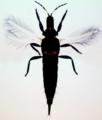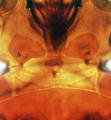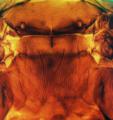Pseudophilothrips avocadis
Recognition data
Distinguishing features
Both sexes fully winged. Body and legs blackish brown, antennal segment III sharply yellow; major setae black, except tergite IX setae pale; fore wing weakly shaded particularly along margins. Head distinctly longer than wide; maxillary stylets retracted to eyes, close together medially; post ocular setae longer than dorsal length of eyes with apices softly rounded; mouth cone extending between fore coxae. Antennae 8-segmented; segment III with one long slender sensorium, IV with three such sensoria; VIII slender and slightly constricted at base. Pronotum with five pairs of long major setae with rounded apices, posteroangular setae almost as long as median length of pronotum; epimeral sutures complete; prosternal basantra not developed, ferna present, mesopresternum divided into paired lateral triangles. Fore tarsus without a tooth. Metanotum with elongate reticulation, median setae longer than distance between their bases. Fore wing parallel sided, with about 25 duplicated cilia; three sub-basal setae sub-equal in length. Tergite IX setae S1 finely acute, about as long as tube.
Male similar to female; tergite IX setae S2 as long as S1; sternite VIII without a pore plate.
Related and similar species
P. avocadis is not known from California, but is included here because it is a potential invader given the expanding avocado cultivation in the State. It is similar in color, size and many details to the hollyhock thrips, P. varicornis, but the fore wings lack a dark median longitudinal line. This species was transferred from the genus Liothrips by Mound et al. (2010). Currently, there are 290 species listed in the genus Liothrips, although 30 of these are placed in two sub-genera known only from Asia. As a result, this is larger than either Thrips or Haplothrips, these three being the largest genera of Thysanoptera. However, in comparison to both Thrips and Haplothrips there are far greater problems in Liothrips in species recognition. A particularly high proportion of the described species are known from single samples, or even single individuals, resulting in little knowledge of variation within and between species, and thus the general assumption that most members of the genus are host-specific requires extensive testing. Stannard (1957) listed 32 species of Liothrips from North America, and subsequently (Stannard, 1968) included 14 of these in his keys to the Illinois fauna. Cott (1957) treated 11 species from California, two of which he placed in Rhynchothrips, but currently from this State there are 13 Liothrips species listed (Hoddle et al., 2004) of which several cannot at present be recognized.
Taxonomic data
Current valid name
Pseudophilothrips avocadis (Hood)
Original name and synonyms
- Liothrips avocadis Hood, 1935: 97
Family placement
Phlaeothripidae, Phlaeothripinae
Biological data
Life history
Breeding on leaves.
Host plants
Persea species (Lauraceae).
Tospoviruses vectored
None
Crop damage
None
Distribution data
Area of origin
Central America
Distribution
Panama, Costa Rica [not known from California].







